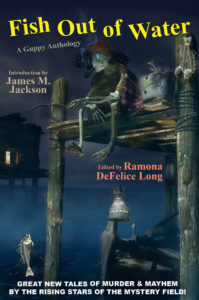Writing short stories is a struggle for me. I prefer to write things that are long and complicated, so working on short pieces feels like I’m riding the brakes all the time. I am very envious of writers who can turn these out regularly.
That’s why I am extra thrilled to announce that my short story, Doppelgangers, is included in a short story anthology from the Sisters in Crime Guppies (Great Under / Unpublished) chapter, FISH OUT OF WATER.

The challenge was simple enough: each story needed to feature a character who is in some matter a fish out of water. Speaking for myself, writing it was anything but simple.
The other stories are all terrific. Hats off to my fellow contributors, including the introduction from Guppy President, James M. Jackson and our wonderful editor, Ramona DeFelice Long. Authors include Beth Green, P. A. De Voe, Anita DeVito, Mo Walsh, Susan Alice Bickford (me!), Liz Milliron, Bern Sy Moss, Rita A. Popp, Cori Lynn Arnold, Chelle Martin, Su Kopil Steve Shrott, Kate Fellowes, Rhonda Lane, Claire Ortalda, KM Rockwood, Melinda B. Pierce, C. C. Guthrie, LD Masterson, Alison McMahan, and Teresa Leigh Judd.
The anthology is available through the publisher Wildside Press
It is also listed on Amazon and Barnes & Noble but availability may vary since the copies are POD (print on demand).
Here is the opening section from my story, Doppelgangers:
The day Robbie Dawson’s father punched out Mr. Wallis in the school bus loading zone, students clustered by the front door let out a cheer. Mr. Wallis taught biology. He was just out of college and not much older than us. And he was cute. But he was a teacher, right?
I had to jump out of the way for Mr. Dawson, who was striding toward Mr. Wallis. Mr. Dawson’s head was thrust out. He walked fast and stiff like his legs wouldn’t bend.
Mr. Dawson grabbed Mr. Wallis by the arm and said something about chins before he smacked Mr. Wallis square on the jaw. When Mr. Wallis didn’t get up, Mr. Dawson stalked back to his car and drove away.
After first period, I went to the principal’s office and said I had lost my field trip form. While I waited I happened to overhear what had set off Mr. Dawson. Mission accomplished.
In our biology class the day before, Mr. Wallis had pointed out that some of us had cleft chins. Thanks to the inheritance of a dominant gene, we lucky few had at least one parent with a cleft chin.
I pressed my index finger into the dent in my chin and a light went on in my brain. I turned and looked at Tessa. She stared back at me, the color drained from her face.
Mr. Wallis had handed Tessa and me the last piece of our shared puzzle. Finally, we had the key for figuring out who our real father was and how to prove we were sisters.
I could have sworn Tessa and I were the only students paying attention in biology that day. Big surprise. It turned out Mr. D-minus, Robbie Dawson, was intellectually on deck for a change and he went home to discuss his cleft chin with his smooth-chinned parents.
That was last spring. Mr. Dawson got arrested. Robbie had to repeat biology in summer school. Mr. Wallis quit.
Tessa and I love you, Mr. Wallis, wherever you are.

